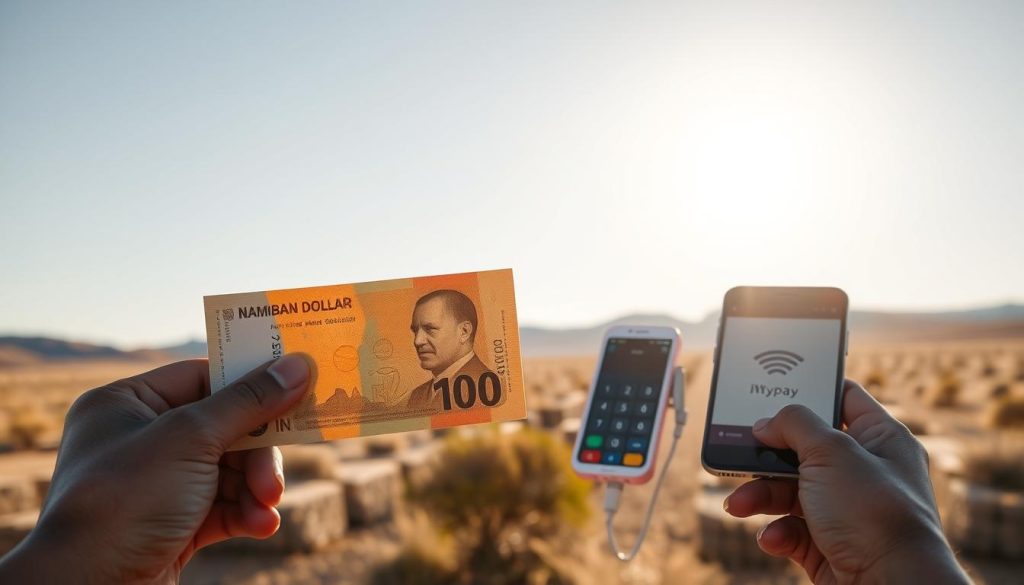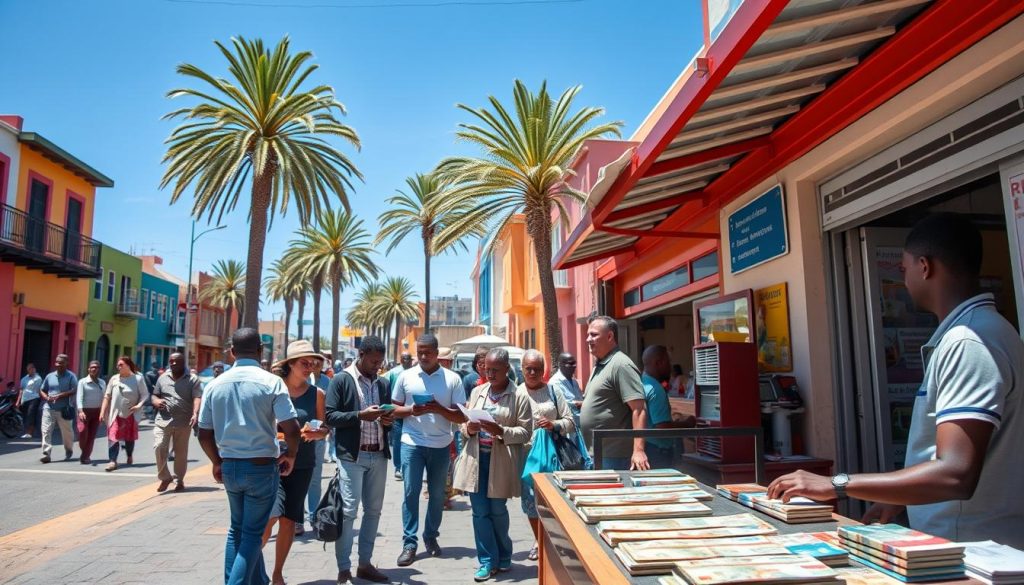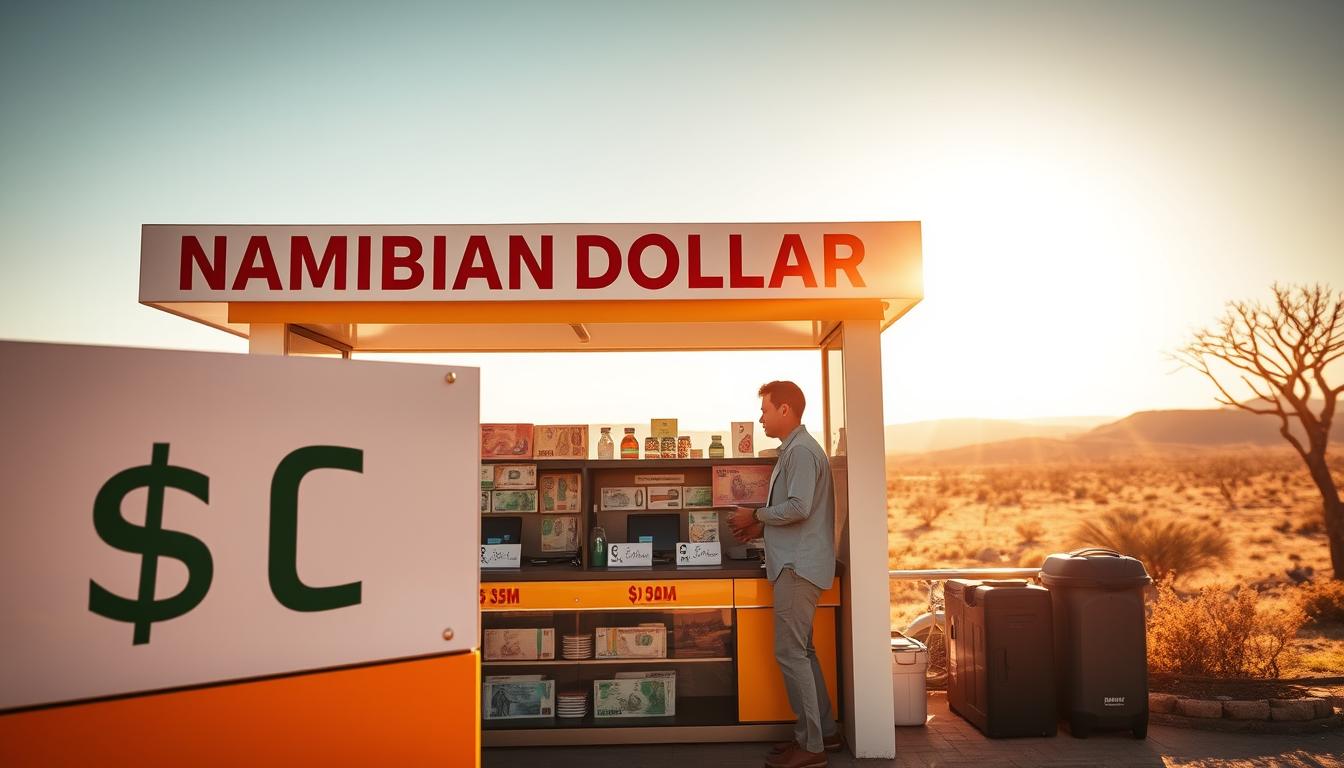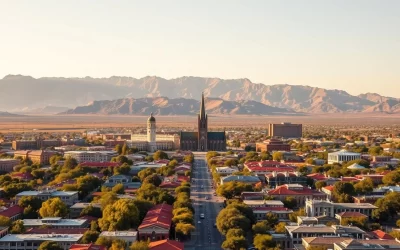✓ Accommodations✓ Flights✓ Rental Cars✓ Tours & Activities
Did you know that exchanging currency at airports can cost you up to 15% more than local banks? This is just one reason why understanding the Namibian Dollar is essential for your trip. Whether you’re planning a safari or exploring the desert, managing your finances wisely ensures a stress-free experience.
Before you embark on your journey, it’s crucial to exchange your USD to NAD. Banks and currency services use the mid-market rate, which offers the fairest conversion. Avoid airport exchanges, as they often have higher fees and less favorable rates.
Carrying both cash and a travel card is the best way to handle payments. While cards are convenient, small purchases and tipping often require the Namibian Dollar. Planning ahead saves you time and money, making your travel experience smoother and more enjoyable.
Introduction to Namibia’s Currency Landscape
Managing your money wisely starts with knowing the local currency. The official currency is the Namibian Dollar (NAD), which has been in circulation since 1993. It’s pegged 1:1 to the South African Rand, making both currencies interchangeable. This unique setup simplifies transactions but also requires careful planning to avoid high fees.
Understanding the economic context is essential. Namibia’s economy relies heavily on mining, agriculture, and tourism, which contribute to the stability of the NAD. This stability ensures that your money retains its value, but global economic shifts can still impact exchange rates. Timing your currency exchange during favorable market conditions can save you significant fees.
Understanding the Economic Context
Namibia’s financial system is managed by the Bank of Namibia, which ensures monetary stability. The country has maintained moderate inflation rates, but external factors like global commodity prices can influence the economy. For travelers, this means staying informed about market trends to make the most of your time and money.
Key Currency Facts
Here are some essential details about the official currency:
- Banknotes come in denominations of 10, 20, 50, 100, and 200 NAD.
- Coins are available in 5, 10, and 50 cents, as well as 1, 2, and 5 NAD.
- Exchange rates fluctuate, so checking the mid-market rate is crucial.
Thisguideequips you with the foundational knowledge needed to manage your finances effectively during your trip.
Understanding the Namibian Dollar and Payment Options
When traveling, understanding the local currency can make or break your budget. The Namibian Dollar (NAD) is the official currency, but the South African Rand (ZAR) is also widely accepted. Both currencies are pegged 1:1, making them interchangeable in most transactions. However, knowing when to use each can save you money and hassle.

Namibian Dollar vs. South African Rand
While the Namibian Dollar and South African Rand are equal in value, some businesses prefer one over the other. For example, smaller vendors might only accept NAD, while larger establishments often take both. It’s a good idea to carry both currencies, especially when visiting rural areas.
Exchange rates can vary slightly, so always check the mid-market rate before converting your money. Avoid dynamic currency conversion (DCC) at ATMs or point-of-sale terminals, as it often includes hidden fees. Instead, opt to pay in the local currency to get the best price.
Cash and Digital Payment Methods
Cash is king for small purchases and tips. Many local markets, taxis, and street vendors only accept cash. Keep smaller denominations handy for convenience. For larger expenses, credit and debit cards are widely accepted in cities and tourist areas.
Here’s a quick comparison of payment methods:
| Payment Method | Best For | Tips |
|---|---|---|
| Cash | Small purchases, tips, rural areas | Carry small bills for convenience |
| Credit/Debit Cards | Restaurants, hotels, shopping | Notify your bank before traveling |
| Travel Cards | Budgeting, avoiding fees | Load with NAD for better rates |
At restaurants, tipping around 10% is customary. Always check if a service charge is already included in the bill. For card payments, ensure the terminal processes the transaction in NAD to avoid extra fees.
By understanding the local currency and payment options, you can manage your finances efficiently and enjoy a stress-free trip.
Namibia: Ultimate Travelers Guide to Currencies & Payments – Currency Essentials
Navigating currency essentials can make your trip smoother and more cost-effective. For the savvy traveller, understanding how to handle local money is key to avoiding unnecessary expenses and maximizing your budget.
Global trends in the world of finance directly impact spending in any destination. Exchange rates fluctuate, and being aware of these changes can help you time your currency conversions better. This ensures you get the most value for your money.
Practical advice is essential for managing your funds. You may want to carry both cash and cards. Cash is ideal for small purchases and tipping, while cards are convenient for larger expenses. Always check for hidden fees when using ATMs or exchanging money.
Here’s why understanding currency essentials matters:
- It helps you avoid overpaying for goods and services.
- You can plan your budget more effectively.
- It ensures you’re prepared for any payment scenario.
By mastering these basics, you’ll enjoy a stress-free and financially savvy travel experience. Whether you’re exploring bustling cities or remote areas, knowing how to handle local currency is a skill every traveller should have.
Strategies for Optimal Currency Exchange
Smart currency exchange strategies can make a big difference in your travel budget. Knowing how to get the best rate and where to exchange your money ensures you save time and avoid unnecessary fees. Let’s explore how to maximize your spending power.
Calculating the Mid-Market Rate
The mid-market rate is the fairest exchange rate available. It’s the midpoint between the buy and sell prices of a currency. To calculate it, check reliable financial platforms or apps like XE or Google Finance. This rate helps you assess whether the offered rate is fair or inflated.
When exchanging money, always compare the mid-market rate to the rate offered by banks or exchange services. If the difference is significant, consider looking for a better deal. This simple step can save you a substantial amount of money.

Avoiding Airport Exchange Pitfalls
Exchanging money at the airport is convenient but often costly. Airport exchange services typically charge higher fees and offer less favorable rates. Instead, plan ahead and exchange a small amount of cash before your trip for immediate expenses.
Once you arrive, use local banks or reputable exchange offices for better rates. If you need cash urgently, withdraw small amounts from ATMs to minimize fees. Avoid dynamic currency conversion (DCC) at ATMs, as it often includes hidden charges.
Here’s why avoiding airport exchanges matters:
- You save money by getting better rates elsewhere.
- You avoid unnecessary fees that can add up quickly.
- You have more control over your budget.
Using a travel card is another excellent way to manage your currency exchange. These cards allow you to lock in favorable rates and reduce transaction fees. Load your card with the official currency to avoid additional conversion charges during your trip.
By following these strategies, you can ensure a smooth and cost-effective travel experience. Whether you’re exchanging cash or using a card, being informed helps you make the most of your money.
Payment Methods in Namibia
Choosing the right payment method can make your trip hassle-free. Whether you prefer digital transactions or traditional cash, understanding your options ensures smooth financial management. Let’s explore the strengths and limitations of each method.
Using Credit and Debit Cards
Debit cards are widely accepted in cities and tourist areas. They offer convenience for larger expenses like hotels and restaurants. However, some rural areas may not support card payments, so carrying cash is essential.
Always notify your bank before traveling to avoid transaction blocks. Check for foreign transaction fees, which can add up quickly. Using ATMs is another option, but be aware of operator fees and dynamic currency conversion (DCC) charges.
Travel Card Advantages
Travel cards are a secure and cost-effective way to manage your money. They allow you to lock in favorable exchange rates and avoid foreign transaction fees. For example, the Wise Multi-Currency Card supports 40+ currencies and offers free ATM withdrawals up to a monthly limit.
Here’s why travel cards are a great choice:
- They reduce the need to carry large amounts of cash.
- They provide security features like PIN protection and fraud monitoring.
- They simplify budgeting by allowing you to preload funds.
Here’s a comparison of popular travel cards:
| Card | Features | Fees |
|---|---|---|
| Wise | 40+ currencies, free ATM withdrawals | Low fees after free limit |
| Travelex | 9 currencies, daily withdrawal limit | 4% foreign transaction fee |
| Westpac | No annual or foreign transaction fees | Higher interest for ATM use |
By understanding the pros and cons of each payment method, you can make informed decisions and enjoy a stress-free trip. Whether you prefer the convenience of cards or the flexibility of cash, planning ahead ensures you’re always prepared.
Tips for Secure and Cost-Effective Transactions
Protecting your money while traveling is just as important as planning your itinerary. Knowing how to handle transactions securely can save you both time and money. Let’s explore actionable tips to ensure your financial safety and avoid unnecessary fees.
Recognizing Dynamic Currency Conversion
Dynamic currency conversion (DCC) is a service offered at ATMs or point-of-sale terminals. It allows you to pay in your home currency instead of the local one. While it seems convenient, DCC often includes hidden fees and unfavorable exchange rates.
To avoid this, always choose to pay in the local currency. This ensures you get the mid-market rate, which is the fairest exchange rate available. Make sure to double-check the terminal or ATM screen before confirming the transaction.
Ensuring Secure Payment Practices
Using a debit card is a popular choice for travelers, but it requires caution. Always notify your bank before your trip to prevent transaction blocks. This step is crucial to ensure uninterrupted access to your funds.
When using ATMs, opt for machines located in secure areas like banks or shopping centers. Avoid standalone ATMs in poorly lit or isolated locations. Make sure to cover the keypad when entering your PIN to protect against skimming devices.
Planning your exchanges in advance can also save you money. Exchange a small amount of cash before your trip for immediate expenses. Once you arrive, use local banks or reputable exchange offices for better rates.
Here are some additional tips for secure transactions:
- Carry a mix of cash and cards for flexibility.
- Use travel cards to lock in favorable exchange rates.
- Monitor your account regularly for unauthorized transactions.
By following these practices, you can enjoy a stress-free and financially secure travel experience. Whether you’re using a debit card or withdrawing cash from an atm, staying informed helps you make the most of your money.
Planning Your Spending and Budget in Namibia
Planning your daily expenses is a key part of any trip. Knowing what to expect helps you stay on track and avoid overspending. Here’s what you need to know to create a realistic budget for your journey.
Start by estimating your daily costs. Meals, transport, and activities are the main things to consider. For example, a meal at a local café costs around $4, while public transport averages $13 per day. These figures give you a baseline for your budget.
Estimating Daily Expenses and Fees
Accommodation is another major expense. A private room in a mid-range hotel costs $45-$60 per night, while a dorm bed is around $8. If you’re exploring national parks, factor in entrance fees of $6 per person.
Here’s a breakdown of typical daily costs:
- Meals: $6-$10 per day
- Transport: $13 per day
- Accommodation: $8-$60 per night
- Activities: $6-$20 per day
Managing costs in different places requires flexibility. In cities, you’ll find more options for affordable meals and transport. Remote areas may have fewer choices, so plan accordingly.
Don’t forget incidental fees like ATM withdrawals or currency exchange charges. These can add up quickly if you’re not careful. Always check for hidden costs to avoid unwelcome surprises.
By creating a detailed budget, you can enjoy your trip without financial stress. Whether you’re in a bustling city or a remote place, planning ahead ensures you make the most of your journey.
Navigating ATMs and Local Banking Services
Accessing cash safely while traveling is a key part of managing your budget. Knowing where to find reliable ATMs and how to use them efficiently can save you time and money. This guide will help you navigate local banking services with confidence.

Finding Reliable ATM Locations
ATMs are widely available in cities and tourist areas, but finding a trusted one is essential. Stick to machines located in secure areas like banks, shopping centers, or hotels. These locations reduce the risk of skimming or theft.
Major banks like Standard Bank, FNB, Nedbank, and Bank Windhoek offer reliable service. Their ATMs are safe and often have lower fees. Avoid standalone machines in isolated spots, as they may not be as secure.
Best Practices for Withdrawals
When withdrawing cash, always check the ATM for suspicious devices. Cover the keypad when entering your PIN to protect against prying eyes. It’s also a good idea to withdraw smaller amounts more frequently to minimize risk.
Here’s a quick checklist for safe withdrawals:
- Use ATMs in well-lit, secure areas.
- Notify your bank before traveling to avoid transaction blocks.
- Withdraw in local currency to avoid dynamic currency conversion fees.
“Planning your ATM visits in advance ensures you stay within your budget and avoid unnecessary fees.”
Balancing your budget requires careful planning. If you’re heading to remote areas, withdraw enough cash beforehand, as ATMs may be scarce. Always keep a small amount of emergency cash in case of unexpected situations.
By following these tips, you can make the most of local banking services and ensure your transactions are secure. Whether you’re in a bustling city or a quiet area, these practices will help you manage your finances effectively.
Leveraging Travel Cards for Smooth Transactions
Travel cards are a game-changer for managing your money abroad. They simplify transactions, reduce fees, and make handling multiple currencies effortless. Whether you’re traveling solo or as a couple, these cards offer unmatched convenience.
Multi-currency travel cards, like the Wise Multi-Currency Card, automatically convert your money at the best rates. This eliminates the need to carry large amounts of cash or worry about unfavorable exchange rates. For example, when tipping at restaurants, your card handles the conversion seamlessly.
Benefits of Multi-Currency Travel Cards
One of the biggest advantages is cost savings. Traditional banks often charge high fees for foreign transactions, but travel cards minimize these costs. They also provide security features like PIN protection and fraud monitoring, giving you peace of mind.
Here’s why these cards are ideal for travelers:
- They support multiple currencies, making them perfect for international trips.
- They reduce the need to carry cash, which is especially useful in remote areas.
- They simplify budgeting by allowing you to preload funds and track expenses.
For a couple, a travel card can streamline shared expenses. You can load the card with funds and use it for everything from meals to activities. This eliminates the hassle of splitting bills or keeping track of receipts.
“A travel card is like having a personal financial assistant—it handles conversions, fees, and security so you can focus on enjoying your trip.”
Here’s a quick comparison of popular travel cards:
| Card | Features | Fees |
|---|---|---|
| Wise | 40+ currencies, free ATM withdrawals | Low fees after free limit |
| Travelex | 9 currencies, daily withdrawal limit | 4% foreign transaction fee |
| Westpac | No annual or foreign transaction fees | Higher interest for ATM use |
When planning your trip, note that some cards offer better rates for specific currencies. For example, the Wise card is ideal for frequent travelers who need flexibility. Always check the supported currencies and fees before choosing a card.
By leveraging a travel card, you can enjoy a stress-free and cost-effective travel experience. Whether you’re tipping at a restaurant or splitting expenses as a couple, these cards make managing your money abroad a breeze.
Reviewing Currency Exchange Sources and Local Insights
Finding the best way to exchange money can save you time and money during your travels. Whether you’re planning a short stay or an extended trip, understanding your options ensures you get the most value for your money.

Online and offline exchange methods each have their benefits. Online tools like currency converters provide real-time rates, making it easy to compare options. However, physical locations like a local shop or hotel offer immediate access to cash, which can be convenient for urgent needs.
Online vs. Offline Exchange Options
Online platforms are ideal for planning ahead. They allow you to track exchange rates and lock in favorable deals before your trip Namibia. Websites and apps often provide detailed insights, helping you avoid hidden fees.
On the other hand, offline options like banks or exchange sites in your destination offer personalized service. For example, a reputable hotel might provide competitive rates for guests. Local shops in tourist areas are also a reliable choice, especially for smaller amounts.
“Choosing the right exchange method depends on your needs—online for planning, offline for convenience.”
Here’s a quick comparison to help you decide:
- Online: Best for tracking rates and avoiding fees.
- Offline: Ideal for immediate cash access and local insights.
By weighing these options, you can make informed decisions and enjoy a stress-free travel experience. Whether you prefer the convenience of a hotel or the flexibility of an online site, planning ahead ensures you get the best value.
Conclusion
Understanding the local financial system can transform your travel experience. By mastering the reasons behind exchange rates and fees, you can make smarter financial decisions abroad. This overview ties together all the cost-saving tips and practical advice shared throughout the guide.
Putting these strategies into practice ensures every dollar works for you. From avoiding hidden fees to choosing the right payment methods, informed planning adds significant value to your trip. These steps not only save money but also reduce stress, letting you focus on enjoying your adventure.
With this final checklist, you’re ready to manage your finances effectively. Whether it’s exchanging money or using travel cards, these tips ensure a smooth and rewarding journey. Take these insights with you and make the most of every moment.
The above is subject to change.
Check back often to TRAVEL.COM for the latest travel tips and deals.






